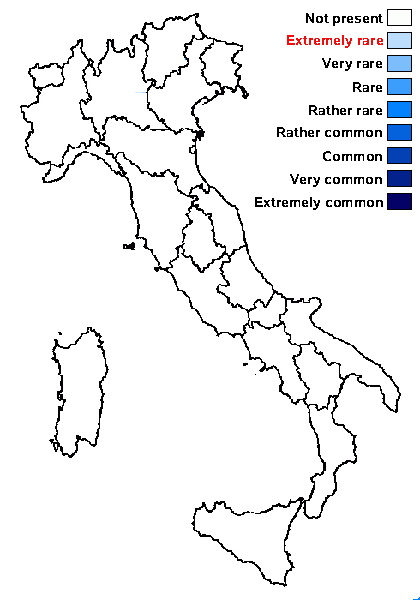Buellia sanguinolenta T.Schauer
Mitt. bot. Statss. München, 5: 620, 1965
Synonyms:
Distribution:
Description: Thallus crustose, thinly episubstratic, continuous or granulose, white-grey, sometimes delimited by a black prothallus. Medulla I-. Apothecia lecideine, black, sessile, (0.3-)0.4-0.6(-0.8) mm across, with a flat to convex, epruinose disc and a thin, persistent or finally excluded proper margin. Proper exciple 60-70 µm wide laterally, K-; epithecium brown; hymenium colourless, 120-140 μm high, inspersed with numerous oil droplets; paraphyses 1-1.5 μm thick at mid-level, the apical cells slightly swollen, 2-3.5(-4) μm wide. Asci 8-spored, clavate to cylindrical-clavate, the apical dome K/I+ dark blue with a pale, conical-pointed apical cushion (axial mass), the wall I-, but the thin outer gel I+ blue, Bacidia-type. Ascospores 1-septate (a few of them rarely 3-septate), brown, often curved, (21-)26-32-(35) x (11-)12-13(-16) µm, Callispora-type, paler at the pointed apices; the inner wall thickened subapically and at septum, the ontogeny of type C (subapical inner wall thickenings produced before septum formation). Pycnidia usually rare, black. Conidia ellipsoid-cylindrical, 3.5-4 x 1-1.5 μm. Photobiont chlorococcoid. Spot tests: thallus K+ yellow turning red (needle-like crystals), C-, KC-, P+ yellow-orange, UV-. Chemistry: atranorin (traces), norstictic and connorstictic acids. Note: a suboceanic species, also known from montane Fagus-Abies forests in Austria; to be looked for in the Italian Alps.
Growth form: Crustose
Substrata: bark
Photobiont: green algae other than Trentepohlia
Reproductive strategy: mainly sexual
Most common in areas with a humid-warm climate (e.g. most of Tyrrenian Italy)

Predictive model
Growth form: Crustose
Substrata: bark
Photobiont: green algae other than Trentepohlia
Reproductive strategy: mainly sexual
Most common in areas with a humid-warm climate (e.g. most of Tyrrenian Italy)

Predictive model
 Index Fungorum
Index Fungorum
 GBIF
GBIF



